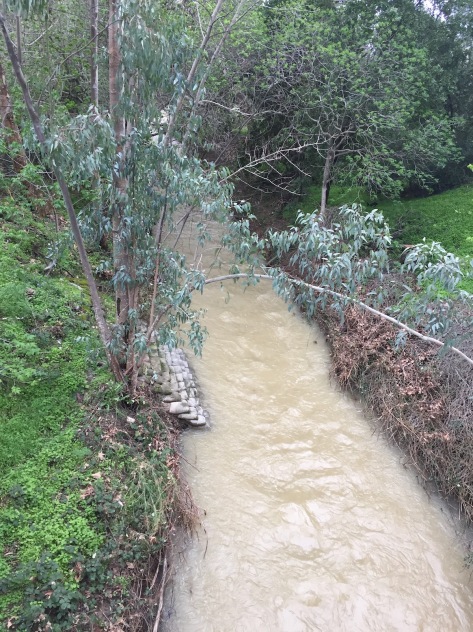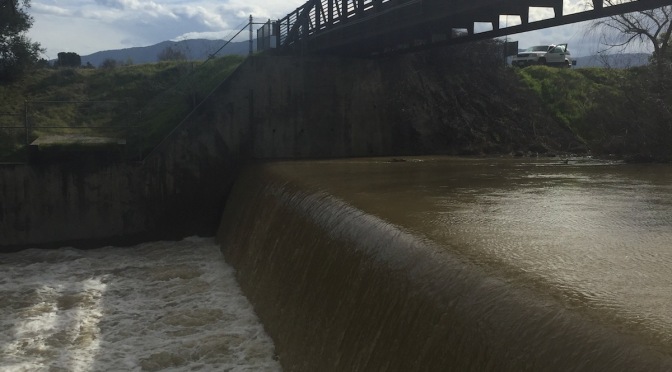The CA drought is officially over in many areas. In fact, there is too much water falling from the sky right now. I’m nostalgic for the dry, sunny days, or even for the fluffy white wintry skiing snow I see falling on my Boston-area friends.
It’s also harder to find geocaches every day in the rain–and impossible to do so without getting wet. Everything is green, gray, and brown here in the Golden State.

I chose this subject for the Mundane Monday Challenge because I want to go a little deeper and find beauty in these flooded, muddy landscapes with their bedraggled vegetation and brownish water.

This evening my son and I were standing outside of a church in Saratoga, waiting to go into a rehearsal. We huddled under an overhang. Another parent walked up, waiting too for the previous rehearsal to end. To make small talk, I said “wild weather we’re having.” He looked around at the pelting rain and wind, and said darkly “the dinosaur water is all gone. This won’t help.”
Dinosaur water. I must have looked puzzled, because, if anything, I associate dinosaurs with oil and other carboniferous resources. “The water we drilled and took out of the ground,” he added. “This won’t put it back.”
The analogy to oil holds there too, but I wondered then, when I got home, how long it actually might take to recharge the aquifers. The San Joaquin Valley is sinking due to overpumped groundwater. According to the San Jose Mercury News, it could take up to 50 years for the groundwater to recharge from its current state, even if everyone stopped pumping immediately. Not quite the millions of years it takes for dinosaurs to turn into oil, but still uncomfortably long in human terms.
Here is something cool, though: aquifer recharge experiments. Wineries and growers of other crops are flooding their fields to get water back in the ground where it is safer from evaporation than it would be in a reservoir. Surprisingly, this doesn’t harm the crops.

The Santa Clara Valley water district maintains percolation ponds, that collect floodwater and direct it back underground. We may be seeing many more of these types of solutions–and flooded lands–in the future!



We have similar problems in large parts of India. Rainwater harvesting and recharging of aquifers is slow to take off. But it turns out that little things like building check dams to hold back rain water until it soaks into the soil apparently do a lot to recharge dinosaur water. Also, using rainwater to recharge underground tanks for personal use cuts down on aquifer water use.
LikeLiked by 1 person
That is very interesting to see how to find beauty very deep unfriendly looking muddy waters!
LikeLiked by 1 person
Didn’t know about the dinosaur water! Yes, your showing the exact state California is in – most places.
Am counting myself blessed right now, that we live in the mountains, with hubby having made good working run-offs to our buildings and property when the drought was still there. Hope your house and yard is okay!
LikeLiked by 1 person
Yes, we’re fine. We’re miles north of San Jose where the worst flooding was. Coincidentally our shower and kitchen sink backed up but that was unrelated to the storm, according to the plumber. And it’s fixed now.
LikeLiked by 1 person
It’s true about the dinosaur water. The acquirer that serves California and seven other states, I believe, is getting past the point of recharge. Since Necessity is the mother of Invention, we’ll either figure something out or follow the dinosaurs, but it’s sad to think the groundwater is gone, gone, gone like a Gillian Flynn novel. Interesting about the grapes. I also would think it would ruin the sugar content or something.
LikeLiked by 1 person
“The San Joaquin Valley is sinking due to overpumped groundwater.” Ha! I KNEW it had to work that way! Drollery thought I was nuts. I think that’s interesting about the vineyards being flooded. You’d think it would have SOME sort of affect on the grapes — taste, color, fragrance… What an interesting post, Karen.
LikeLiked by 1 person
The article I linked to has lots of specifics about the sinking. It’s a real problem, damaging the very aqueduct that brings water to the San Joaquin Valley! Apparently the vineyard flooding has to be with very cold water, and it stops in May. Then the grapes are unharmed. No details about what happens if the water is too warm or it goes on too long into summer.
LikeLiked by 1 person
I read the article. Fascinating.
LikeLiked by 1 person
Wao… This is so beautiful
LikeLike
You sure got great shots of rushing muddy water. Well done. It might be a while before we see that in California again.
LikeLiked by 1 person